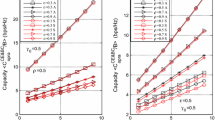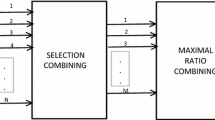Abstract
In this paper, closed-form expressions for capacities per unit bandwidth for fading channels with impairments due to Branch Correlation are derived for optimal power and rate adaptation, constant transmit power, channel inversion with fixed rate, and truncated channel inversion policies for maximal ratio combining diversity reception case. Closed-form expressions for system spectrum efficiency when employing different adaptation policies are derived. Analytical results show accurately that optimal power and rate adaptation policy provides the highest capacity over other adaptation policies. In the case of errors due to branch correlation, optimal power and rate adaptation policy provides the best results. All adaptation policies suffer no improvement in channel capacity as the branch correlation is increased. This fact is verified using various plots for different policies. With increase in branch correlation, capacity gains are significantly larger for optimal power and rate adaptation policy as compared to the other policies. The outage probability for branch correlation is also derived and analyzed using plots for the same.












Similar content being viewed by others
References
Proakis, J. G. (1995). Digital communications. NY: McGraw Hill.
Jakes, W. (1994). Microwave mobile communications (2nd ed.). Piscataway, NJ: IEEE Press.
Gans, M. (1971). The effect of Gaussian error in maximal ratio combiner. IEEE Transactions on Communication Technology, 19(4), 492–500.
Kong, N., & Milstein, L. B. (1998). Combined average SNR of a generalized diversity selection combining scheme. In IEEE international conference on communications 98, Atlanta, USA, pp. 1556–1560.
Digham, F., & Alouini, M. (2004). Average probability of packet error with diversity reception over arbitrarily correlated fading channels. Journal of Wireless Communications and Mobile Computing, 4(2), 155–173.
Lu, J., Tjhung, T. T., & Chai, C. C. (1998). Error probability of L-branch diversity reception of MQAM in rayleigh fading. IEEE Transactions on Communications, 46(2), 179–181.
Aalo, V., & Pattaramalai, S. (1996). Average error rate for coherent MPSK signals in Nakagami fading channels. Electronics Letters, 32(17), 1538–1539.
Al-Hussaini, E. K., & Al-Bassiouni, A. A. M. (1985). Performance of MRC diversity systems for the detection of signals with Nakagami fading. IEEE Transactions on Communications, 33(12), 1315–1319.
Norklit, O., & Vaughan, R. G. (1998). Method to determine effective number of diversity branches. In IEEE global telecommunications conference (GLOBECOM), vol. 1. Sydney, Australia, pp. 138–141.
Simon, M. K., & Alouini, M. S. (1998). A unified approach to the performance analysis of digital communication over generalized fading channels. Proceedings of the IEEE, 86(9), 1860–1877.
Simon, M. K., & Alouini, M. S. (1999). A unified performance analysis of digital communications with dual selective combining diversity over correlated Rayleigh and Nakagami-\(m\) fading channels. IEEE Transactions on Communications, 47(1), 33–43.
Bhaskar, V. (2008). Error probability for L-branch coherent BPSK equal gain combiners over generalized Rayleigh fading channels. International Journal of Wireless Information Networks, 15(1), 31–35.
Annavajjala, R., & Milstein, L. (2003). On the performance of diversity combining schemes on Rayleigh fading channels with noisy channel estimates. In IEEE Military communications conference (MILCOM ’03), vol. 1. Boston, MA, pp. 320–325.
Goldfeld, L., & Wulich, D. (2003). Adaptive diversity reception for Rayleigh fading channel. European Transactions on Telecommunications, 14(4), 367–372.
Mallik, R. K., Win, M. Z., Shao, J. W., Alouini, M. S., & Goldsmith, A. J. (2004). Channel capacity of adaptive transmission with maximal ratio combining in correlated Rayleigh fading. IEEE Transactions on Wireless Communications, 3(4), 1124–1133.
Dietrich, F. A. (2003). Maximum ratio combining of correlated Rayleigh fading channels with imperfect channel knowledge. IEEE Communications Letters, 7(9), 419–421.
Bhaskar, V. (2007). Spectrum efficiency evaluation for MRC diversity schemes under different adaptation policies over generalized Rayleigh fading channels. International Journal of Wireless Information Networks, 14(3), 191–203.
Alouini, M., & Goldsmith, A. (1999). Capacity of Rayleigh fading channels under different adaptative transmission and diversity combining techniques. IEEE Transactions on Vehicular Technology, 48(4), 1165–1181.
Alouini, M., & Goldsmith, A. (1997). Capacity of Nakagami multipath fading channels. In Proceedings of IEEE vehicular technology conference (VTC ’97), vol. 1, Phoenix, AZ, USA, pp. 358–362.
Gradshteyn, I., & Ryzhik, I. (1994). Table of integrals, series, and products (5th ed.). San diego, CA: Academic Press.
Author information
Authors and Affiliations
Corresponding author
Appendices
Appendix 1
The Spectrum Efficiency for OPRA policy is obtained by substituting (2) into (7) of [18] as
Substituting \(\mu _1 =\frac{\gamma _0 }{\Gamma (1+\varepsilon )}\) and \(\mu _2 =\frac{\gamma _0 }{\Gamma (1-\varepsilon )}\), \(t=\frac{\gamma }{\gamma _0 }\) and \(\hbox {dt} =\frac{d\gamma }{\gamma _0 }\) in (29), we have
From Eq. (2) of section 4.331 on p. 567 in [20], we have \(\int _1^\infty e^{-\mu t}\ln tdt=-\frac{1}{\mu }E_i (-\mu ),[\mathfrak {R}e\mu >0]. \) Substituting this expression in (30), we obtain the capacity for OPRA policy in (6). The optimal policy suffers a probability of outage, \(\hbox {P}_{\mathrm{out}}^{\mathrm{(BC)}}\) given by
Making change of variables in the integral of (31), where \(\eta _1 =\frac{1}{\Gamma (1+\varepsilon )}\) and \(\eta _2 =\frac{1}{\Gamma (1-\varepsilon )}\), we have
Substituting \(\int \nolimits _0^{\gamma _0 } {\exp (-\mu x)=\frac{1-\exp (-\gamma _0 \mu )}{\mu }} \) into (32) and simplifying, we have the outage probability expression as in (7). Substituting (2) into Eq. (29) of [18], we have
From Eq. (1) of section 4.337 on p. 568 in [20], we have \(\int \nolimits _0^\infty \exp (-\mu x)\log _e (\beta +x)dx=\frac{1}{\mu }[\log _e (\beta )-e^{(\mu \beta )}E_i (-\beta \mu )],\;\forall \;[\left| {\arg \beta } \right| <\pi ,\mathfrak {R}e{}\mu >0]. \)
Substituting \(\beta = 1, \eta _1 =\frac{1}{\Gamma (1+\varepsilon )},\) and \(\eta _2 =\frac{1}{\Gamma (1-\varepsilon )}\) in (33), we have
Integrating the above equation, we obtain the expression for capacity for ORA policy as in (8).
Substituting (2) into Equation (46) of [18], we have
Since the closed-form expression is not possible for \(\int \nolimits _0^\infty {\frac{\exp \left( {-\gamma } \right) }{\gamma }d\gamma } \), we find the numerical limits for \(\upgamma \) through simulation, and substitute the minimum and maximum values as limits to give
Using Eq. (3) of Section 3.352 in [20], we obtain the expression for capacity of CIFR policy as in (9). Substituting (35) into Eq. (47) of [18], we have
Making change of variables in the integral of (37), we have
From Eq. (2) of section 3.352 on p. 343 in [20], we obtain the expression for capacity of TIFR policy as in (10).
Appendix 2
Figure 2a, b through Fig. 5a, b show the simulation of the system through the steps discussed below.
Step 1: The base for the simulation is to find out numerical instantaneous SNRs (\(\upgamma )\). This is obtained from the CDF of the received instantaneous SNR (\(\upgamma )\) for branch correlation at the output of two branch system given in (2), i.e.
Step 2: The CDF is equated to a uniform random number. Then, 10\(^{6}\) Uniform random numbers are generated using rand command in MATLAB.
Step 3: The maximum and minimum values of U are found out.
Step 4: The maximum value of received SNR \((\upgamma _{\mathrm{max}})\) and the minimum value of received SNR \((\upgamma _{\mathrm{min}})\) are found for different values of Individual Branch SNRs \(({\Gamma })\), different values of Correlation \((\upvarepsilon )\) and different number of diversity orders (M) as tabulated below.
M \(=\) 2; \(\bar{\gamma }=\) 5 dB | M \(=\) 2; \(\upvarepsilon = 0.5\) | ||||||
|---|---|---|---|---|---|---|---|
E | \(\upgamma _{\mathrm{max}}\) | \(\upgamma _{\mathrm{min}}\) | Range | \(\bar{\gamma }\) | \(\upgamma _{\mathrm{max}}\) | \(\upgamma _{\mathrm{min}}\) | Range |
0.1 | 37 | 0.0375 | 36.9625 | 1 | 18 | 0.0135 | 17.9865 |
0.2 | 38 | 0.037 | 37.963 | 2 | 22 | 0.0165 | 21.9835 |
0.3 | 40 | 0.036 | 39.964 | 3 | 28 | 0.0207 | 27.9793 |
0.4 | 42 | 0.0354 | 41.9646 | 4 | 35 | 0.026 | 34.974 |
Step 5: Using the maximum and minimum values of instantaneous SNRs \((\upgamma )\), the capacity for all four policies is obtained for different values of \({\Gamma }, \upvarepsilon \) and M by approximating the integral as a numerical summation from \(\upgamma _{\mathrm{min}}\) to \(\upgamma _{\mathrm{max}}\) in steps of 0.001.
Step 6: The simulated capacity values for all four policies for different values of correlation, \(\upvarepsilon \), at \({\Gamma } = 5 \hbox {dB}\) are compared with the corresponding analytical results for the above four cases. Figure 1a, b through Fig. 4a, b show the analytical versus simulated graphs for capacity for the case of impairments due to branch correlation errors.
Rights and permissions
About this article
Cite this article
Bhaskar, V., Subhashini, J. Spectrum Efficiency Evaluation with Diversity Combining for Fading and Branch Correlation Impairments. Wireless Pers Commun 79, 1089–1110 (2014). https://doi.org/10.1007/s11277-014-1919-4
Published:
Issue Date:
DOI: https://doi.org/10.1007/s11277-014-1919-4




